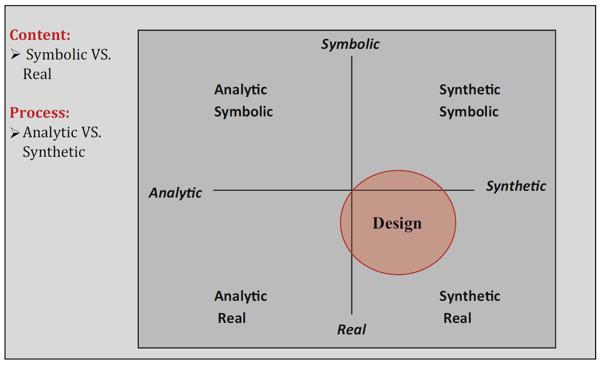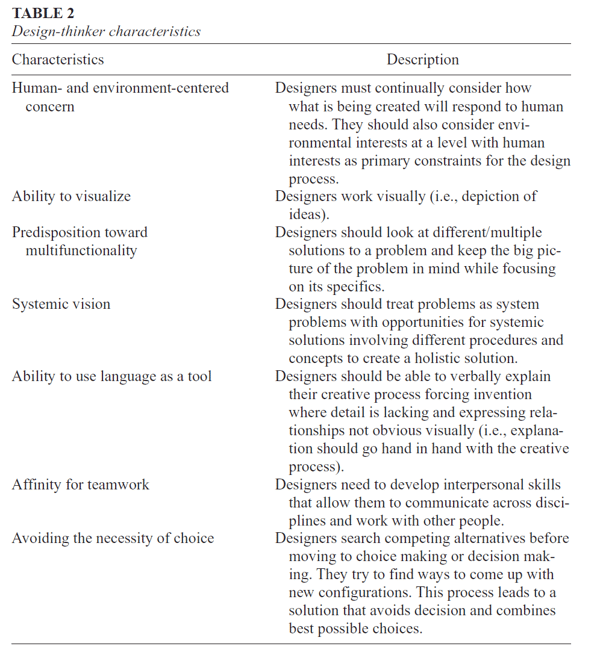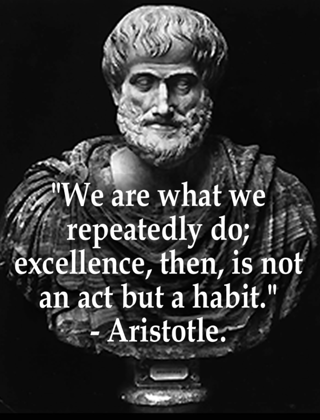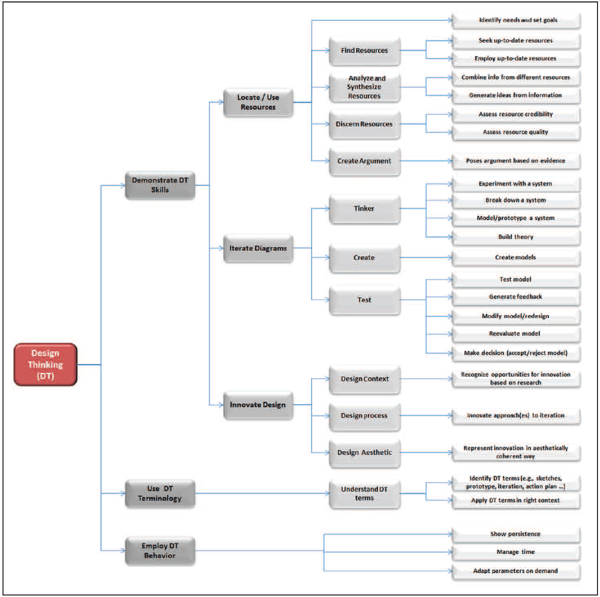Design Thinking 101
Definitions of engineering abound, as do definitions of design. A general characterization of what engineers do: engineers “scope, generate, evaluate, and realize ideas”.

This characterization focuses on how engineers think and embraces the heart of the design process by highlighting the creation (i.e., scoping and generation), assessment, and selection (i.e., evaluation), and the making or bringing to life (i.e., realization) of ideas.
Scholars have argued that the knowledge of technical systems or analysis is not sufficient to understand the thought processes that lead to successful design and successful engineering solutions, and that studying those thought processes is critical to improving design methodologies.
What does the word “design” mean in an engineering context? Why is this complex, fascinating subject so hard to teach? The definition of design adopted here sets a course for answering these questions:
Engineering design is a systematic, intelligent process in which designers generate, evaluate, and specify concepts for devices, systems, or processes whose form and function achieve clients’ objectives or users’ needs while satisfying a specified set of constraints.
This definition promotes engineering design as a thoughtful process that depends on the systematic, intelligent generation of design concepts and the specifications that make it possible to realize these concepts. While creativity is important, and may even be teachable, design is not invention as caricatured by the shouting of “Eureka” and the flashing of a light bulb. Design problems reflect the fact that the engineer has a client (or customer) who, in turn, has in mind a set of users (or customers) for whose benefit the designed artifact is being developed.
The design process is itself a complex cognitive process. There are many informative approaches to characterizing design thinking, some of which are now detailed. These characterizations highlight the skills often associated with good designers, namely, the ability to:
-
tolerate ambiguity that shows up in viewing design as inquiry or as an iterative loop of divergent-convergent thinking
-
maintain sight of the big picture by including systems thinking and systems design
-
handle uncertainty
-
make decisions
-
think as part of a team in a social process
-
think and communicate in the several languages of design
Nature of Design Thinking
In many fields, knowledge is generated and accumulated through action (i.e., doing something and evaluating the results). That is, knowledge is used to produce work, and work is evaluated to produce knowledge. Creative people tend to work in two different ways: either as finders or as makers of engineering solutions.
Finders demonstrate their creativity through discovery. They are driven to understand and to find explanations for phenomena not well understood. Makers are equally creative, but they are driven to synthesize what they know in new constructions, arrangements, patterns, compositions, and concepts.
Given the fundamental process differences between how finders and makers think and work, other factors might similarly reveal differences among professional engineering fields and therefore help to define the nature of mechanical design thinking.

One such factor is the content with which a field works. A conceptual map can be drawn to represent both content and process factors. Two axes define the map. Separating the map into left and right halves is an analytic/synthetic axis that classifies fields by process (i.e., the way they work).
Fields on the left side of the axis are more concerned with finding or discovering; fields on the right are concerned with making and inventing. A symbolic/ real axis divides the map into halves vertically.
Fields in the upper half of the map are more concerned with the abstract, symbolic world, as well as the institutions, policies, and language tools that enable people to manipulate information, communicate, and live together.
Fields in the lower half are concerned with the real world and the artifacts and systems necessary for managing the physical environment. Four quadrants result from this division.
The first is analytic/symbolic, which includes fields like science that are heavily analytic in their use of process and their content is more symbolic than real in that subject matter is usually abstracted in its analyses.
The second quadrant is synthetic/symbolic, which includes fields that are concerned extensively with the symbolic content and synthetic processes. For instance, law falls in this quadrant because it is concerned with the symbolic content of policies and social relationships, and most of its disciplines are concerned with the creation of laws, or codes of conduct.
The third quadrant is analytic/real, which on the content scale involves reality and on the process scale is strongly analytic. Medicine, for example, falls into this quadrant because it is highly concerned with real problems of human health and diagnostic processes are its primary focus. The fourth is synthetic/real, which involves fields, such as design, that include synthesis processes and real content.
In this mapping (represented by a circle), design falls in the fourth quadrant because it is highly synthetic and strongly concerned with real-world subject matter. However, because disciplines of design deal with communications and symbolism, design has a symbolic component, and because design requires analysis to perform synthesis, there is also an analytic component.
It is important to note that a case can be made for the positioning of any field to the left or the right of the map.
However, mapping fields is relative and not absolute, which is important because this mapping provides a means for comparing the relationships among different fields with respect to the two dimensions: content and process.
Each of the four quadrants in this figure is important in engineering design because we want our engineering interns to develop higher-order thinking skills and be able to analyze, synthesize, innovate, and thus readily deal with real-world problems as they become professional engineers.
Characteristics of a Design Thinker
Table 2 summarizes some design thinker characteristics.
Although the nature of design thinking and what makes one person a design thinker and another not remain elusive, a number of characteristics have been identified and can be useful in understanding how a design thinker thinks and approaches issues.
These characteristics are also helpful in understanding the nature of design thinking. In addition to these characteristics that a design thinker should possess, there are several processes underlying the design thinking process.

Design Thinking as Divergent-Convergent Questioning
Asking questions emerges as a beginning step of any design project in the problem definition phase.
No sooner has a client defined a series of objectives for a designed artifact than the designers—whether in a real engineering firm or in the field—want to know what the client really wants.
What is a safe product? What do you mean by cheap? How do you define the best?
Questioning is clearly an integral part of design.
On the other hand, the majority of the educational content taught in today’s engineering curricula is an epistemological approach, systematic questioning, where known, proven principles are applied to analyze a problem to reach verifiable, “truthful” answers or solutions.
While it seems clear that systematic questioning describes engineering analysis well, does it apply in a design context?
One would expect an affirmative answer to this question, in part because design educators already argue that the tools and techniques used to assist designers’ creativity are “…ways of asking questions, and presenting and viewing the answers to those questions as the design process unfolds”.
Further, since the accepted basic models of the design process show iterative loops between various stages of design, it is clear that questioning of various kinds takes place at varying stages of the process. Aristotle proposed that “the kinds of questions we ask are as many as the kinds of things which we know”. In other words, knowledge resides in the questions that can be asked and the answers that can be provided.

A hierarchy in Aristotle’s approach has been identified: certain types of questions need to be asked and answered before others can be asked. For instance, it would be unsound, misleading, and ineffective to question or reason about the cause of a phenomenon before verifying its existence and understanding its essence. Aristotle’s ordering thus reveals a procedure, which constitutes the inquiry process in an epistemological context.
Taxonomies of this procedure or inquiry process have been extended to computational models, to the relationship between question asking and learning, and to the types of questions engineering interns ask during mentoring sessions.
One of the major strengths of today’s engineering curricula is their ability to implicitly convey to engineering inters that Aristotelian procedure as a framework for approaching engineering problems. In fact, the incidence of a specific class of questions, termed deep reasoning questions, has been shown to correlate positively with student learning in a science context.
If deep reasoning questions are indeed related to learning performance when it comes to comprehending and reasoning about a specific body of material, then an effective inquiry process would follow “Aristotle’s procedure,” where lower-level questions related to the existence, essence, and attributes of a phenomenon precede the deep reasoning questions related to the phenomenon itself.
The nature of systematic questioning in a design context , and whether it differs from the epistemological inquiry process, has also been considered by observing and analyzing how designers think and question. More than 2,000 questions posed by designers in team meetings (in a series of quasi-controlled laboratory experiments in which 36 designers worked in teams of three) were extracted and coded. Interestingly, 15 percent of the questions could not be placed in any of the categories identified in any published taxonomies of questions, which suggests the possibility that designers’ inquiry and thinking processes might have unique, identifiable characteristics.
A common premise of the foregoing discussion is that a specific answer, or a specific set of answers, exists for a given question. Such questions are characteristic of convergent thinking, where the questioner attempts to converge on and reveal “facts.” Therefore, answers to converging questions are expected to be hold truth value, that is, to be verifiable. Deep reasoning questions are such questions.
Questions that are asked in design situations, however, often operate under a diametrically opposite premise: for any given question, there exist multiple alternative known answers, regardless of being true or false, as well as multiple unknown possible answers. The questioner intends to disclose the alternative known answers and to generate the unknown possible ones. Such questions are characteristic of divergent thinking, where the questioner attempts to diverge from facts to the possibilities that can be created from them.
These types of questions could be termed generative design questions. The questioner is not necessarily concerned with the truthfulness or verifiability of potential answers when posing a generative design question. The key distinction between the two classes is that convergent questions operate in the knowledge domain, whereas divergent questions operate in the concept domain. This has strong implications for teaching conceptual design thinking since, as the recently proposed concept-knowledge theory also argues, concepts need not have truth value, whereas knowledge does.
Design thinking is thus seen as a series of continuous transformations from the concept domain to the knowledge domain. Such questioning and thinking also reflect the process by which designers add to the store of engineering knowledge. The significance of the transformations between the concept and knowledge domains is further supported by the finding that the combined incidence of deep reasoning questions and generative design questions correlate with performance in obtaining engineering and design solutions.
Therefore, effective inquiry in design thinking includes both a convergent component of building up to asking deep reasoning questions by systematically asking lower-level, convergent questions, and a divergent component in which generative design questions are asked to create the concepts on which the convergent component can act. Teaching divergent inquiry in design thinking is neither recognized clearly nor performed well in engineering curricula.
For example, it is not acceptable for a student to respond to a final exam question in an engineering science course by providing multiple possible concepts that do not have truth value. Indeed, students are expected to engage in a convergent process by formulating a set of deep reasoning questions and working to the (unique) answer. Students’ ability to converge is being positively assessed when partial credit is given for the “thought process,” even if the answer is wrong. In this context, engineering curricula may be characterized as follows:
-
One of the main strengths of engineering curricula is their perceived effectiveness in conveying Aristotle’s epistemological, convergent inquiry process. It promotes the ability to reason about knowledge associated with mathematics and sciences, which is construed as the engineering science or reductionist model.
-
Divergent inquiry takes place in the concept domain, where concepts or answers themselves do not have truth value, that is, they are not necessarily verifiable. This is the design or synthesis model. It often seems to conflict with the principles and values that are at the core of the predominantly deterministic, engineering science approach.
The foregoing discussion raises the following question: Can the now more-formal identification of both divergent thinking and design as an iterative divergent-convergent process be used to develop better pedagogical approaches to both engineering design and engineering analysis?
Thinking About Designing Systems
In recent decades designers have helped develop an increasingly complex, human-built world that includes ambitious large-scale engineering projects. At the same time, designers are making engineered products and systems increasingly complex as they work to improve robustness by increasing the number of components and their interdependencies.
Further, designers are now required to expand the boundaries of the design to include such factors as environmental and social impacts in their designed systems.

These trends suggest that engineering designers need skills that help them cope with complexity. In response, many universities have created specialized programs for system design, systems engineering, and closely related areas. This section reviews research on the system design and systems thinking skills that good designers exhibit and that engineers should experience.
The specific aspects of systems thinking discussed here—recognizing the systems context, reasoning about uncertainty, making estimates, and performing experiments—might be characterized as desirable habits of any engineering firm that also reflect the notion of convergent-divergent thinking discussed just above.
1) Thinking about system dynamics:
A hallmark of good system designers is that they can anticipate the unintended consequences emerging from interactions among the multiple parts of a system. This kind of foresight is essential for designing engineering systems and managing the design process. A large body of work has been conducted on reasoning about system dynamics under the rubrics of systems thinking and system dynamics.
Unfortunately, this skill is not common and can be difficult to learn. Engineering and mathematics education was a significant benefit for the simpler tasks studied, but was far from significant in its beneficial effects on the more difficult tasks. Many different teaching methods have been proposed to improve people’s abilities to reason qualitatively about system dynamics.
2) Reasoning about uncertainty:
Engineering design is conducted with imperfect models, incomplete information, and often with ambiguous objectives as well. The effects of such uncertainties are even more prominent in the design of systems. Some have argued that undergraduate engineering curricula greatly under emphasize the application of probability and statistics in engineering. Numerous studies in cognitive psychology have shown that people are prone to serious errors in probabilistic and statistical thinking, such as the neglect of prior probabilities, insensitivity to sample size, and misconceptions of regression.
Formal mathematical training in probability and statistics reduces some errors but has little effect on others, e.g., systematic underestimation of uncertainty. A new statistics concept inventory (SCI) has been developed that has revealed that statistics courses did not significantly improve people’s conceptual understanding of statistics. However, recent research suggests some promising new approaches.
Communicating possible outcomes in term of frequencies—rather than probabilities—can significantly improve the validity of inferences drawn and the effectiveness of their communication. Educators in engineering and related disciplines have been working to overcome these difficulties by emphasizing conceptual understanding, using more hands-on teaching methods, and using more graphics and simulations.
Design thinking could be furthered by including (1) probability and statistics courses early in the curriculum, (2) uncertainty in engineering analysis courses, and (3) more emphasis on experimentation as a design activity. One widely acknowledged path to improvement is to make better use of modern computational tools to support probabilistic thinking.
3) Making estimates:
One of the challenges of engineering design is that, as the number of variables and interactions grows, the system stretches beyond designers’ capability to grasp all of the details simultaneously. One strategy for bringing a system back within the limits of human mental capacity is to focus selectively on a limited number of factors, preferably the most important ones.
Good mechanical engineering designers are usually good at estimation—they can efficiently determine the relative sizes of physical parameters and identify those that can safely be neglected, at least for specific purposes. Unfortunately, typical engineers are generally not good at estimation.
A test in which engineers were asked to estimate a physical quantity within five minutes, for example, the energy stored in a battery and the drag force on a bicycle and rider at a given speed. The estimates on each question varied greatly, with inter-quartile ranges of roughly three to five orders of magnitude, depending on the question. This poor performance seems to be related to a weak conceptual understanding of basic engineering science and a limited ability to form appropriate analogies.
Engineering education currently emphasizes sophisticated methods for precise calculation and thus may under emphasize skills related to approximation. Teaching methods and curricular designs for improved approximation skills represent a promising area for research and development.
4) Conducting experiments:
The design of systems is rarely accomplished exclusively by applying fundamental scientific principles. In most cases, the engineering and design of systems also requires some use of empirical data and experimentation. This fact is driving a trend to teach engineers the design of experiments so they can more efficiently plan experiments and analyze and understand the results.
These techniques are now widely taught in industry through “six sigma” programs, as well as through more traditional college and professional engineering programs. The methods of experiment design are now widely disseminated and are having a significant impact throughout industry. However, the statistical methods of experiment design alone will not be sufficient for engineers to learn effectively through experimentation.
Engineers must also learn to alternate between inductive processes and deductive processes, using physical understanding or engineering models to inform the experimental approach and then updating their understanding and models based on data. There is potentially great promise in research on how to teach engineers to make coordinated use of engineering models and experiments.
Making Design Decisions
All agree that mechanical engineering designers make decisions throughout the design process, and several decision-centric design methods and frameworks have been developed in recent years. The common underlying concept in these decision-based design frameworks is that design is a rational process of choosing among design alternatives. Some have questioned whether design decisions are scientifically or mathematically sound.
Scholars have argued that to make engineering design a truly rational process that produces “the best possible results…, a mathematics of design is needed…based on the recognition that engineering design is a decision-intensive process and adapting theories from other fields such as economics and decision theory”.
They extended their argument by leveraging decision theory to construct a set of axioms for designing and to derive two theorems that could be applied to construct statistical models that would account for uncertainty, risk, information, preferences, and external factors such as competition. This approach arguably results in numerous decisions, only one of which would be optimal.
They also stressed that goals are an essential feature of design and necessitate decisions as to how they should be achieved. It is further argued that exploring the relationship between design decisions and the performance of the resulting solutions is fundamental to design, with optimization used to introduce goal-seeking directly into design exploration.
Design Thinking in a Team Environment
To an increasing degree, design is being recognized and taught as a team process with multiple socio-technological dimensions. One practical reason is that the ABET general engineering criteria target the social aspects of engineering education at several levels:
- an ability to design a system, component, or process to meet desired needs
- addresses the need to function on multidisciplinary teams
- social and ethical responsibilities
- communication skills
- addresses global and social impact
- practical skills
Constructivist theories of learning recognize that learning is a social activity, and both cornerstone and capstone project-based courses are seen as opportunities to improve students’ ability to work in teams, as well as their communication skills. As a result, campuses now incorporate many of these dimensions in their design classes.
The Languages of Engineering Design
Different languages are employed to represent engineering and design knowledge at different times, and the same knowledge is often cast into different forms or languages to serve different purposes. Yet engineers seem to believe that mathematics is the language of engineering, perhaps because of the pervasive use of mathematics to formulate and solve engineering problems in the engineering-as-applied-science curriculum.

As may be inferred from much of the foregoing discussion, and as will also be seen in the discussion of drawing and sketching below, design requires the use of languages in addition to mathematics—as do many other types of human cognition. Design knowledge includes knowledge of design procedures, shortcuts, and so on, as well as knowledge about designed objects and their attributes.
Designers think about design processes when they begin to sketch and draw the objects they are designing. A complete representation of designed objects and their attributes requires a complete representation of design concepts—e.g., design intentions, plans, behavior, and so on—that are harder to describe or represent than are physical objects.
In fact, the roles that languages play in design have been discussed in both philosophical and grammatical terms. The several languages or representations used in design, both in practice and in research, include the following:
-
verbal or textual statements used to articulate design projects, describe objects, describe constraints or limitations, communicate between different members of design and manufacturing teams, and document completed designs
-
graphical representations used to provide pictorial descriptions of designed artifacts such as sketches, renderings, and engineering drawings
-
shape grammars used to provide formal rules of syntax for combining simpler shapes into more complex shapes
-
features used to aggregate and specialize specified geometrical shapes that are often identified with specific functions
-
mathematical or analytical models used to express some aspect of an artifact’s function or behavior, where this behavior is in turn often derived from some physical principle(s)
-
numbers used to represent discrete-valued design information (e.g., part dimensions) and parameters in design calculations or within algorithms representing a mathematical model
Researchers have studied various aspects of the roles of textual language in the work of design teams.
For example, Scholars measured the relation of design creativity to the number of noun phrases generated by design teams during conceptual design.
Results from the analysis suggest a positive correlation between design outcomes and patterns of the average semantic coherence over time, as well as with variation in semantic coherence between design stages.
This research provides empirical evidence of the phenomena of changing levels of coherence in “story telling” in design and in the scope of design concepts explored by design teams.
The results indicated that design teams that challenged assumptions throughout the design process, with cyclical semantic coherence, performed better than teams that had little variation over the design process.These results support the hypothesis that high performing design teams cycle between divergent and convergent patterns of thinking and questioning.
Understanding and analyzing sketching activities are ongoing research topics within the design education and research community because sketching is an integral and important part of the design process. Sketching also provides another language or representation that can be used to store design solutions and to highlight conflicts and possibilities. It can also form a basis for revising and refining ideas, generating concepts, and facilitating problem solving.
Therefore, sketching can have a positive impact on the quality of the designed solution and on the individual experience of the design process. Serving as an aid for analysis, short-term memory, communication, and documentation, sketching can also facilitate and hasten the development of ideas and concepts into a successful product.
In a detailed case study of engineering design, the timing of sketch types is one of the factors in the design process that contributes to a design’s success or failure. The study suggested that there is a statistically significant correlation between the quantity of early, dimensioned drawings and the graded design outcome.
Experts in the Design Process
Expert design engineers solve complex problems more easily than novices. During a conceptual design process, experienced designers do not just synthesize solutions that satisfy given requirements, they also invent design issues or requirements that capture important aspects of a given problem that assist in solving the problem at hand.
From protocol studies of experienced engineering designers, it was found that the manner by which experts approach a problem is related to the degree and type of previous experience. More experienced designers tend to use generative reasoning (i.e., an inductive approach) compared to less experienced designers who employ more deductive reasoning (depth-first approach). In other words, designers with specific experiences related to the problem type approached the design task through solution assumptions/ conjectures instead of problem analysis.
This hypothesis suggests that experience in a specific problem type enables designers to perceive the design problem in terms of relevant solutions that they have previously encountered. Designers also tend to change goals and constraints as they design. They are flexible in selecting and trying different engineered solutions.

However, when designers face unexpected difficulties and/or shortcomings in the solution concept, they tend to stick to their principal solution concept as long as possible through the design process. For instance, from case studies of professional architectural designers, it was observed that the designers’ choices for problem-solving directions were influenced by their initial design ideas.
Furthermore, the designers made every effort to make these ideas work whenever a problem was encountered, rather than adopting a new idea. And although this fixedness proclivity may sound maladaptive, scholars observed the same phenomenon in their protocol studies of experienced mechanical engineering designers. They found that experienced designers typically pursued only one design proposal. And even when major problems had been identified, the designers preferred to modify the initial proposal rather than rejecting it and developing a new one.
Likewise, a similar conclusion was drawn from studies of senior electrical engineers conducting real-world projects. The researchers stated that when the designers generated a less than satisfactory solution, they refused to discard the original solution or spend time and effort coming up with an alternative one.
Rather, they tended to improve the solution by developing different versions until a workable solution was achieved. Again, the designers indicated a fixation behavior on initial concepts. Nonetheless, adherence to initial concepts seems to comprise normal expert design behavior.
Since a problem cannot be fully understood in isolation, expert designers use conjectures as a means of helping them to explore and understand the formulation of the problem. From protocol studies of experienced industrial designers,it was asserted that the designers start by exploring the problem and find, discover, or recognize a partial structure. Afterwards, they use this partial structure to generate initial ideas for the form of a design concept, then expand and develop the partial structure.
Thus, their goal is to create a matching solution to the problem. Having more than one solution concept should stimulate a more comprehensive evaluation and understanding of the problem. From the analysis and synthesis of the literature, it appears that there are a number of competencies that designers should acquire and hone. The more experience a designer builds in these competencies, the more he or she advances along the novice-expert continuum.
Design Thinking Competency Model
This competency model represents an operationalization of the design thinking construct and may also help drive the creation of appropriate activities that would allow for the collection of relevant evidence to inform variables in the model. For example, consider the variable “Iterate Diagrams” in Figure 2.
Skills associated with this variable include tinkering, creating, and testing ideas via diagrams. Testing, in turn, entails initial testing of the design idea, getting feedback, modifying the design, reevaluating it, and making a decision to accept or reject the modeled idea.
To assess engineering intern competency levels relative to the iterate diagrams variable, we would have to put them in a situation in which those constituent skills could be employed, such as in a game or simulation. Diagnostically, the model could provide the framework for evaluating the degree to which interns are demonstrating particular design thinking skills at various times and at various grain sizes relative to the model.

The design thinking competency model is useful for assessment and diagnostic purposes. That is, once the key knowledge and skills have been identified, then tasks and activities can be developed in line with the model’s variables. Another relevant question concerns whether these skills are learnable.
With sufficient practice within meaningful environments, along with scaffolded support and formative feedback, we believe that engineering interns can learn design thinking skills. Moreover, pedagogical approaches that involve problem-based learning, project-based learning, and inquiry-based learning can be used to enhance engineer's design thinking skills within the context of evocative and consequential real-world activities.
Such learner-centered approaches can help to raise engineers' awareness about good design processes and generally enhance their interest in solving complex problems. Associated activities could be designed in a way that requires design engineers to generate ideas/solutions, receive support for their emergent design thinking skills, as well as ongoing feedback about the feasibility of various solutions.
Professional engineers can support their interns in developing these skills by providing them with multiple and varied opportunities to design and create prototypes, experiment with different ideas, collaborate with others, reflect on their learning, and repeat the cycle while revising and improving each time. In summary, the premise is that by improving engineering interns’ design thinking skills through having them apply processes and methods that designers use to help them experience how designers approach problems to try to solve them, interns will be more ready to face problems, think outside of the box, and come up with innovative solutions. We believe that design thinking is more than just a skill to be acquired and used in limited contexts. Rather, we view it as a way of thinking and being that can potentially enhance the epistemological and ontological nature of mechanical design thinking.






